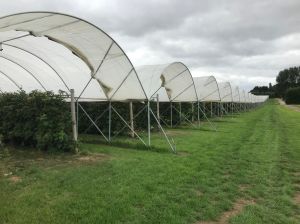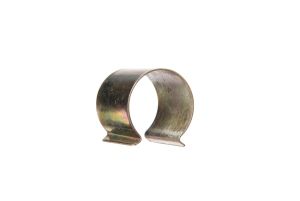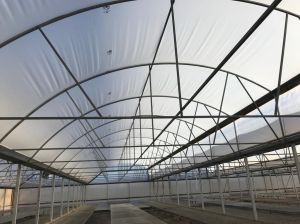Tunnel film: Condensation and fog

The warmer the air is, the more moisture it can contain. The colder the air, the less moisture it can contain. When it is warm inside the greenhouse or tunnel and colder outside, condensation forms on the foil.
Condensation is the process by which H2O vapours in the air are converted from gas to liquid. Condensation occurs when warmer moist air comes into contact with colder surfaces, foil in this case.
Then there is the dew point. The dew point is the point at which the temperature to which the air must be cooled in order to become saturated with water vapour is reached. When air is cooled further, the water vapours condense in the air to form liquid water (dew). When air cools to the dew point through contact with a colder surface, the water condenses on the film.
.jpg)
Figure 1: Relationship between temperature, relative humidity and dew point.
The above table makes it clear that the formation of water from vapours depends only on temperature and relative humidity.
Why do we get drops on our film?
This is due to surface tension. Now we are getting a bit technical. Droplets are formed because of the tendency of liquid surfaces to shrink into the smallest possible area. It is due to the difference in surface tension. Surface tension is measured in dyn/cm units. The difference in surface tension between water (72 dyn/cm) and polyethylene (31 dyn/cm) or EVA (33 dyn/cm) causes the water to form droplets. These droplets, which accumulate on the film, will increase in size and eventually fall off.

Negative effects of water droplet accumulation:
- Reduction of light transmission.
- Constant dripping on the plants increases humidity and promotes leaf diseases.
- Lens effect can cause burns.

Anti-condensation, also known as Anti-Drip, prevents dripping by turning the film into an evenly thin layer.

To prevent condensation or drop formation, anti-condensation additives are added to the film. These additives, which consist of molecules with a hydrophobic tail and a hydrophilic head, migrate to the film surface, increasing the surface tension; thus, a single water layer can be formed without disturbing the optical properties and without dripping.

As soon as there is a uniform layer of water on the foil, the migration of Anti-Condens to the surface starts again: new molecules migrate to the surface washed by the water flow, and so on.
Gravity causes the water layer to flow down into the gutters, hence the importance of adequate slope (which explains why it is very difficult to have an Anti-Condensation effect with horizontal film installation).
Factors determine the life span of the Anti-condensation:
- Use of the right Anti-Condens additive, depending on the application and climate;
- Appropriate amount of Anti-Condens in the foil;
- Thickness of the film (the thicker the film, the more Anti-Condens it can contain);
- Structure of the film, e.g. balance between different polymers.
Conditions of use that influence the Anti-Condens life span:
- Extreme temperatures (high/low) exposure to film;
- Greenhouse structure: efficient ventilation, height, adequate roof slope;
- Greenhouse conditions: humidity, water leaks, high evaporation from the floor (mulch);
- Surface without crop.
A water layer on the foil acts as an IR barrier and reduces the cooling of greenhouses during cold nights. Therefore the combination of Anti-Condensation and IR is recommended.
Fog
Greenhouse fog or mist is created by a sudden change in temperature: water vapour cooling below the dew point forms microdroplets.

Anti-Mist Films
FruitSecurity Holland offers a variety of Anti-Mist films adapted for wide range of applications: cold/warm, long/short life, high/normal transparency.
All kinds of Anti-Mist foils can be combined with other properties, such as: chemical resistance, thermal IR-film, light scattering film, cooling effect, etc.
-Solarisation (temperature increasing film): using Anti-Mist film for solarisation improves efficiency by increasing soil temperature.

Figure 2: Comparison between ordinary and anti-fog solar film
SOURCE: Institute of Agricultural Technology
As always, we are happy to set new standards in the field of plastic products for industry and agriculture and to provide our customers with all their needs.











